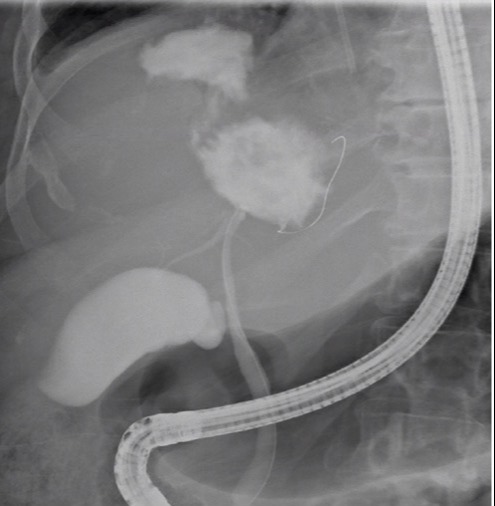Back


Poster Session D - Tuesday Morning
Category: Biliary/Pancreas
D0057 - A Rare Case of Delayed Bilioptysis Due to Radioemobilization of Intrahepatic Cholangiocarcinoma: Case Report and Review of Literature
Tuesday, October 25, 2022
10:00 AM – 12:00 PM ET
Location: Crown Ballroom

Has Audio

Jessica Hollingsworth, MD
Atrium Health Wake Forest Baptist
Winston-Salem, NC
Presenting Author(s)
Jessica Hollingsworth, MD, Brian Kouri, MD, Swati Pawa, MD
Atrium Health Wake Forest Baptist, Winston-Salem, NC
Introduction: Bronchobiliary fistula (BBF) is a rare condition that describes a pathologic communication between the biliary tree and bronchial airway. It can occur in the setting of trauma, infection, malignancy, or iatrogenesis. Bile in sputum (bilioptysis) is pathognomonic. We present a rare case of BBF managed with both ERCP and IR embolization.
Case Description/Methods: A 73-year-old female was diagnosed with large intrahepatic cholangiocarcinoma in segment 7/8 and was treated with systemic chemotherapy and radioembolization of the segment 6/7/8 branches of her right hepatic artery. Approximately 10 months after the initial radioembolization, residual viable disease in the right lobe of the liver was treated with repeat radioembolization combined with microwave ablation. Eighteen months after the initial radioembolization, she presented with progressive productive cough unresponsive to antibiotics and steroids. Her cough then turned bright yellow concerning for bilioptysis, and she was admitted for presumed BBF. CT thorax showed right lower lobe pneumonia, enlarging pulmonary nodules, and multiple peripherally enhancing liver lesions. ERCP was performed and established the diagnosis of BBF, via cholangiography, which was treated with biliary sphincterotomy and placement of a 10 Fr x 12 cm double pigtail stent into the biloma. Immediate reduction of bright yellow sputum was observed. Subsequent HIDA scan showed a large biloma overlying the right hepatic dome and persistent BBF. The patient underwent embolization of the BBF and placement of percutaneous drain into the biloma. The patient’s bilioptysis has resolved for three weeks, and further embolization of the BBF has not been necessary. The patient has stabilized and is scheduled have a follow up ERCP.
Discussion: Intrahepatic cholangiocarcinoma treated with radioembolization is a rare cause of BBF. The pathophysiology includes chronic subdiaphragmatic inflammation with breakdown of the local diaphragm and lung tissue or frank invasion of the diaphragm and lung by an active liver process. Due to the infrequent presentation of this entity, there is no treatment protocol established for management of BBF. ERCP is a minimally invasive option that can be considered for both diagnosis and treatment of BBF, either alone or in conjunction with IR embolization.

Disclosures:
Jessica Hollingsworth, MD, Brian Kouri, MD, Swati Pawa, MD. D0057 - A Rare Case of Delayed Bilioptysis Due to Radioemobilization of Intrahepatic Cholangiocarcinoma: Case Report and Review of Literature, ACG 2022 Annual Scientific Meeting Abstracts. Charlotte, NC: American College of Gastroenterology.
Atrium Health Wake Forest Baptist, Winston-Salem, NC
Introduction: Bronchobiliary fistula (BBF) is a rare condition that describes a pathologic communication between the biliary tree and bronchial airway. It can occur in the setting of trauma, infection, malignancy, or iatrogenesis. Bile in sputum (bilioptysis) is pathognomonic. We present a rare case of BBF managed with both ERCP and IR embolization.
Case Description/Methods: A 73-year-old female was diagnosed with large intrahepatic cholangiocarcinoma in segment 7/8 and was treated with systemic chemotherapy and radioembolization of the segment 6/7/8 branches of her right hepatic artery. Approximately 10 months after the initial radioembolization, residual viable disease in the right lobe of the liver was treated with repeat radioembolization combined with microwave ablation. Eighteen months after the initial radioembolization, she presented with progressive productive cough unresponsive to antibiotics and steroids. Her cough then turned bright yellow concerning for bilioptysis, and she was admitted for presumed BBF. CT thorax showed right lower lobe pneumonia, enlarging pulmonary nodules, and multiple peripherally enhancing liver lesions. ERCP was performed and established the diagnosis of BBF, via cholangiography, which was treated with biliary sphincterotomy and placement of a 10 Fr x 12 cm double pigtail stent into the biloma. Immediate reduction of bright yellow sputum was observed. Subsequent HIDA scan showed a large biloma overlying the right hepatic dome and persistent BBF. The patient underwent embolization of the BBF and placement of percutaneous drain into the biloma. The patient’s bilioptysis has resolved for three weeks, and further embolization of the BBF has not been necessary. The patient has stabilized and is scheduled have a follow up ERCP.
Discussion: Intrahepatic cholangiocarcinoma treated with radioembolization is a rare cause of BBF. The pathophysiology includes chronic subdiaphragmatic inflammation with breakdown of the local diaphragm and lung tissue or frank invasion of the diaphragm and lung by an active liver process. Due to the infrequent presentation of this entity, there is no treatment protocol established for management of BBF. ERCP is a minimally invasive option that can be considered for both diagnosis and treatment of BBF, either alone or in conjunction with IR embolization.

Figure: Cholangiography demonstrating bronchobiliary fistula.
Disclosures:
Jessica Hollingsworth indicated no relevant financial relationships.
Brian Kouri indicated no relevant financial relationships.
Swati Pawa indicated no relevant financial relationships.
Jessica Hollingsworth, MD, Brian Kouri, MD, Swati Pawa, MD. D0057 - A Rare Case of Delayed Bilioptysis Due to Radioemobilization of Intrahepatic Cholangiocarcinoma: Case Report and Review of Literature, ACG 2022 Annual Scientific Meeting Abstracts. Charlotte, NC: American College of Gastroenterology.
